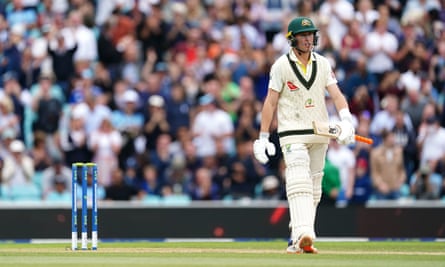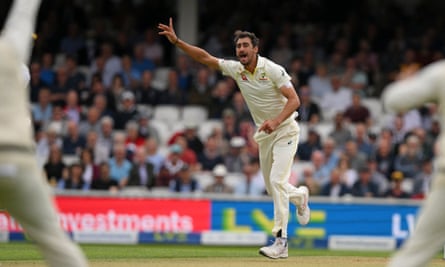England 2-2 Australia: player ratings for the drawn Ashes series
England
Ben Stokes: 405 runs at 45.0; three wickets at 29.7; six catches
The captain was hampered by injury throughout, barely bowling, but remainedthe focus of attention in the field as the challenge set to batters was modified hour-by-hour, often ball-by-ball. He almost corrected the excesses of Bazball in the first two Tests – his, let’s say, surprising declaration at Edgbaston and the unhappy hooking at Lord’s – with his astonishing, six-strewn 155 at Lord’s. He ended the series content with his side’s work in captivating the public, but knowing that the Ashes were going back to Australia, an opportunity missed. Grade B+
Zak Crawley: 480 runs at 58.3; nine catches
Pressure? What pressure? The poster boy for the “Bazball is a cult” critics met the first ball of the series with a crashing cover drive, provoking a deep intake of breath from the Australians and a huge roar from the Edgbaston crowd. He carried on from there, giving world class operators nowhere to bowl, scattering the field and vindicating the faith of his captain and coach – h is 189 at Old Trafford, compiled in just 57 overs, was an innings for the ages. England’s best slipper. Grade A
Ben Duckett: 321 runs at 35.7; nine catches
The diminutive left-hander, who complements his towering right-handed opener partner so well, only got the returns his positive batting deserved at Lord’s, where he had his second splendid Test of the summer. His approach of rarely leaving a ball gets the innings off to a supercharged start, with singles available on either side of the wicket, but the inevitable nicking off is going to frustrate purists and those who are tempted to forget that averaging 35 opening in an Ashes series is not a bad outcome at all. Grade B-
Moeen Ali: 180 runs at 25.7; nine wickets at 51.4
The all-rounder answered the call and played through the pain barrier, scoring handy runs as a stand-in No 3 and taking useful wickets. It gave us a glimpse of what might have been. Stokes’ attacking fields and willingness to accept that boundaries will sometimes be hit bolstered Ali’s confidence, which has wilted in the past under less sympathetic captains. He did not hold an end, but he got Marnus Labuschagne and Travis Head out twice each and Steve Smith once – which will do. Grade B-

Ollie Pope: 90 runs at 22.5; one catch
He had three busy starts in his four innings but could not go beyond a top score of 42 before a dislocated shoulder ended his series. Grade C
Joe Root: 412 runs at 51.5; six wickets at 28.7; 11 catches
Could the prog rocker adapt to the punk world of Stokes and McCullum? It looked a bit like dad dancing last year, but he discovered his pogo (the reverse scoop off 85mph+ deliveries) and a kind of joy flooded his batting, scampered singles and textbook boundaries punctuated by absurd lifts over third man. Of course, he left some runs on the field (though he put plenty in the scorebook) but do not underestimate the impact his unequivocal buy-in to the project has on younger players. He also bowled well and squeezed some very decent catches into that ridiculous workload. Grade A
Harry Brook: 363 runs at 40.3; no wicket; three catches
The Yorkshire master blaster can make the game look far too easy, just standing there and hitting boundaries at will, down the ground or off the line of the stumps, cut through the covers.But the game exacts a revenge on those who consciously or subconsciously begin to believe their own publicity and his part as one of the Lord’s lemmings seems to have chastened him a little. He was a better batter for it later in the series. Grade B
Jonny Bairstow: 322 runs at 40.3; 23 catches; one stumping
After a leg-break on the golf course that was as bad as those suffered by motorcycle racers, it was something of a miracle he was there at all. He caught well (especially on that heartstopping last day at the Oval) but he caught badly too – and sometimes Root at first slip had to do his work for him. There’s no hiding place for a wicketkeeper, so every scrappy take, every return that escaped the gloves, and every missed opportunity had his critics grinding their teeth again. He was, though, selected primarily for his game-changing attributes with the bat, and few English keepers have contributed so impressively, but two of those performances came in the defeat at Lord’s and the washout at Manchester, so do not loom as large in the memory. Grade B
Chris Woakes: 79 runs at 19.8; 19 wickets at 18.1; one catch
A perfect complement to his pal, Mark Wood, at the other end, the metronomic seamer curbs his ambition and bowls a length that pulls a batter on to the front foot and a line that demands he play the ball. In England, these deceptively simple virtues are enough to get good batters out and he did. He was playing T20 cricket for the Birmingham Bears while England were losing the first two Tests, a rare selection error from Stokes and McCullum. Grade A-

Mark Wood: 83 runs at 20.8; 14 wickets at 20.2
When England needed a fillip, 2-0 down and staring at one of the great letdowns in Ashes history, Wood brought the heat of his bowling and the warmth of his smile to terrorise the batters and lift the crowd. He even swung the ball at the Oval and swung the bat to good effect everywhere. Playing three Tests in four weeks took its toll, but he never stopped trying no matter his body’s demand that he ease off. Grade A-
Ollie Robinson: 59 runs at 19.7; 10 wickets at 28.4
The figures look better than the performances did at the time. Despite looking short of pace, he took wickets in all four innings of the first two Tests, including each of Australia’s top three, but then fitness concerns raised their head (again) at Headingley, where he was largely a passenger. He was not trusted to play in the last two Tests. Grade B-
Josh Tongue: 20 runs at 10.0; five wickets at 30.2; one catch
A surprise selection at Lord’s, he instantly looked at home, flogging some life out of a moribund strip with well-directed bouncers sustained over longish spells. His five wickets comprised Smith twice, David Warner twice and Usman Khawaja, which shows that while he lacks Wood’s genuine pace, he can get good players out on flat pitches. That highly credentialed trio will be the first of many Test wickets. Grade B+
Stuart Broad: 78 runs at 13.0; 22 wickets at 28.4
To borrow an old Ashes line: “Who writes your scripts?” As ever, the sight of a green and gold helmet 20 yards away revved up the heart rate, his fire burning as bright as ever at 37. Broad was a consistent threat to the Australians, often finding movement off the seam, especially from around the wicket to the left-handers. When he didn’t findit, he used his personality and mastery of the dark arts to make things happen. It might irk him to say so, but Dennis Lillee must have recognised something of himself in England’s now-retired pacer. Grade A-
James Anderson: 28 runs at 9.3; five wickets 85.4; one catch
A series too far for England’s record-breaker? He cut something of a poignant figure amid the Broad love-in at the Oval, a peripheral presence in a series he could not dominate. He never found the zip off the pitch, the ball leaving his fingers without the veneer of magic that has moved it this way and that for 20 years, the length hard to smash but easy to miss if the occasional delivery did go off the straight. Grade D

Australia
Patrick Cummins: 162 runs at 23.1; 18 wickets at 37.7; four catches
His primary objective was to retain the Ashes and he did it. Cummins was handed an unfair itinerary (six Tests in eight weeks, going from the field to the media room to the hotel, barely seeing a friendly face along the way while grumbles filtered through from back home) yet he stood up well as a captain and bowler under the Bazball hammer. His fields never suggested an effective plan to counteract England’s aggression at the top of the order and he was shorn of his world class spinner after one match, but dealt with four lost tosses, the worst of the batting conditions and a ball-change in the fifth Test that transformed the match without complaint. He also played the most important innings of the series to get his team over the line at Edgbaston. Had he not done so, things could have unravelled very quickly for the world champions. Grade B+
Usman Khawaja: 496 runs at 49.6; two catches
The old-school opener sat deep in his crease, bided his time and resisted England and temptation for 1,263 deliveries to post the highest runs-aggregate in the series and remind us how things once were. Scores of 141, 65, 17 (in 107 minutes) and 77 in the two wins that retained the Ashes show just how effective he was in fulfilling his job description. He had a hard job and he did it well. Grade A
David Warner: 285 runs at 28.5; four catches
Did the announced January retirement, the hostility of the crowd and England’s openers outwarnering Warner spook him a little? Though Headingley was his only real failure of a match, his list of unconverted starts betrayed his unease at the crease. He only looked comfortable during England’s curiously flat fourth day at the Oval. Warner was never quite the walking wicket of 2019, but he never quite solved problems that endure four years later. Grade C+
Marnus Labuschagne: 328 runs at 32.8; no wickets; one catch
Like his role model a slot below him in the order, he found just one century: an important one that helped Australia secure the weather-assisted draw at Old Trafford. It was a series in which he threatened more than he delivered. His 22 runs from 115 deliveries at the Oval looked bizarre – a few boundaries hit in either innings would have changed things considerably at the match’s conclusion. Grade B-

Steven Smith: 373 runs at 37.3; no wickets; 11 catches
All was not well inside the Smith bubble, his frustration evident as he failed to access the higher plane on which he has operated so many times against England. His balance was fractionally off, which meant he could not quite work the ball into the gaps at will and, like all of us as we get older, an impatience that things are not as they once were seeped into his play. He scored an important century at Lord’s but looked no more than a competent middle-order bat elsewhere. Grade B
Travis Head: 362 runs at 36.2; two wickets at 46.0; two catches
He was given plenty of opportunities to work on his perceived weakness to the short ball by England’s bowlers and, a little uncomfortably at times, he largely dealt well with the barrage, flinching uncomfortably but accepting the challenge and scoring plenty of runs as a result. He carried the fight to the hosts when a bit of pushback was sorely needed. Grade B
Mitchell Marsh: 250 runs at 50.0; three wickets at 55.7; two catches
Like Woakes, the English-conditions specialist was not called upon until the third Test but instantly looked at home despite his lack of preparation. Alongside Head, he was the only Australian batter who tried to transfer the pressure back on to England, striking the ball cleanly, his big frame manoeuvred into position by surprisingly effective footwork. England will be pleased that his swing bowling, alternating with the splice-smiter as a variation, was curiously underemployed by his captain. Grade A-
Cameron Green: 103 runs at 20.6; five wickets at 47.0; four catches
The giant all-rounder with the big reputation looked a little green on his first Ashes tour. He failed to convert starts with the bat and hit the deck hard with the ball, but could not get the movement to trouble batters regularly. He certainly delivered on his third skill, catching spectacularly well in the gully. Green was forced out of the XI by Mitchell Marsh, an English-conditions expert. Grade C
Alex Carey: 200 runs at 22.2; 21 catches and five stumpings
His keeping was excellent (after a tough drop in the first Test) until his vast workload caught up with him. His batting tailed off too, unfortunately underlining Broad’s jibe that the stumping of his opposite number at Lord’s would be the thing for which he is remembered. Grade B-
Mitchell Starc: 82 runs at 16.4; 23 wickets at 27.1; one catch
We know exactly what we will get from the big left-arm quick and that’s what we got in the four Tests he played. Some balls were too good to edge, some balls were too bad to miss out on and the in-between ones were defended or took wickets. The Bazball philosophy of hitting decent deliveries for four probably helped him as other bowlers looked inconsistent too, even if they were not. He took plenty of wickets and could have had plenty more. Grade A-

Nathan Lyon: 28 runs at 9.3; nine wickets at 29.3
Australia’s one truly indispensable tourist pulled up lame at Lord’s and, in that moment, Cummins lost both his best chance to put a brake on English scoring rates and 100 consecutive Tests of experience in the dressing room – and it showed. He bowled and batted superbly in the one Test he completed. Grade A-
Todd Murphy: 76 runs at 19.0; seven wickets at 25.9
Has ever as grizzled a veteran as Nathan Lyon been replaced by as callow-looking a youth as Todd Murphy? But looks can deceive. Like his coach, Daniel Vettori, he hides a fiercely competitive nature behind scholarly spectacles that take five years off his age. He bagged his fair share of wickets with decent turn and controlling accuracy, and was never collared, not by today’s standards anyway. He will be back and, if he can generate some of Lyon’s overspin, he will be even more effective. Grade B+
Scott Boland: 20 runs at 10.0; two wickets at 115.5
The Victorian pacer looked to have a game ideally suited to English conditions, hitting the seam regularly with a repeatable action at decent pace, but he was washed away by Storm Bazball. Grade D-
Josh Hazlewood: 20 runs at 6.7; 16 wickets at 31.7; two catches
He came into the series with fitness issues and could not find the easy rhythm that characterises his best work. His basics are so good that he still conjured a wicket in each of the innings in which he bowled and slipped in for a fivefer amid the carnage at Old Trafford. It was a strangely nondescript series from a great bowler, perhaps overshadowed unfairly by the noise that surrounded so much of the action. Grade B